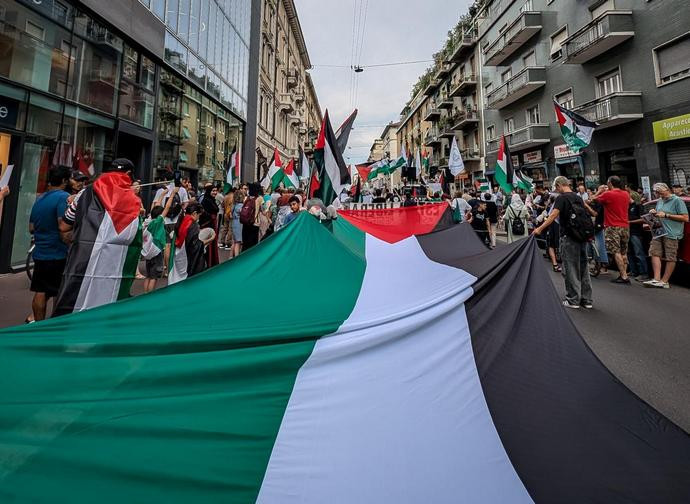'Two states’ solution to Israel-Palestine conflict is unrealistic
The rush by Western countries to recognise a Palestinian state does not take into account the complexity of the situation and could have the opposite effect: the acceleration of Israel's military plans. Nor does it consider the decisive religious factor in the conflict.

Following French President Emmanuel Macron's announcement on 25 July, the United Kingdom and Canada have also embarked on the path towards recognising the Palestinian state, albeit in different ways. While France will present its decision at the UN General Assembly in September, British Prime Minister Keir Starmer will take the diplomatic step if Israel does not stop the massacres in Gaza. Canadian Prime Minister Mark Carney, meanwhile, has set the condition of democratic reforms and elections within the next year, excluding Hamas. Germany is now considering it too, and pressure is mounting on the Italian government.
The stated goal is to push Israel to stop and give new impetus to the process towards 'two peoples, two states', a solution also proposed by Vatican Secretary of State Cardinal Pietro Parolin in recent days.
However, although this is presented as the only way forward, it is more accurate to say that, in the current situation, it is a dead end. While these decisions may be good for propaganda and give the impression that something is being done for peace and to appease growing Islamic minorities in Western countries, in reality they are ineffective and outdated initiatives, if not counterproductive.
There are many reasons for this. Historically, it is precisely the two-state solution that lies at the root of the conflict. It was the solution approved by the UN General Assembly in 1947 (Resolution 181), but rejected by the Arabs. This immediately led to war as Israel proceeded unilaterally in the meantime. Since then, three wars have been fought between Israel and the Arab countries (in 1948, 1967 and 1973), resulting in subsequent border changes in Israel's favour. Furthermore, there have been continuous uprisings in the Palestinian territories occupied by Israel since 1987. Although some Arab countries now recognise Israel, the root causes of the conflict remain unchanged. Indeed, the situation on the ground has become more complicated after almost 80 years of conflict, not to mention the exponentially increasing mutual hatred in this cycle of violence.
It is difficult to imagine that the cause of a war could also be its solution.
Nonetheless, a window of opportunity did open in 1993 with the signing of the Oslo Accords by Israeli Prime Minister Yitzhak Rabin and Palestinian President Yasser Arafat. During this promising period, the Holy See initiated talks with both Israel and the Palestinian Authority. It established diplomatic relations with Israel in 1994 and cooperation agreements with the Palestinian Authority, leading to full diplomatic recognition in 2015.
However, Rabin's assassination in 1995 by an extremist Jewish settler and the collapse of the Camp David negotiations in 2000 between Israeli Prime Minister Ehud Barak and Arafat brought an end to this period, resulting in significant changes in both Israel and the Palestinian territories, as we shall see later.
There are also a number of practical reasons. Today, 147 out of 193 countries recognise the State of Palestine, and many others have relations with the Palestinian Authority. If this has had no impact on the conflict, what basis is there for expecting anything to change if the number rises to 150 or 155? Just because they are European or Western countries? This is a rather weak argument. The only diplomatic recognition that would make a difference is precisely what is lacking: mutual recognition between Israel and Palestine, and recognition of Israel by countries in the region that currently refuse to do so, led by Iran. This is not a trivial matter. What would be the point of having two neighbouring states — assuming it were possible to impose them — that do not recognise each other and would continue to wage war in order to destroy each other?
Another question concerns the territory under Palestinian authority. Is it realistic to revive the 1947 plan given all the changes that have taken place on the ground in the meantime? Can anyone seriously consider moving more than half a million Jews living between East Jerusalem and the West Bank (who are among the most extremist), not to mention the two million Arabs living in Israel?
Who would represent the Palestinian state? The Palestinian Authority (PNA) has been suggested, but it is widely discredited among Palestinians and this flurry of diplomatic recognition is a reaction to the war in Gaza, where Hamas remains the leading force. In fact, it is Hamas that is involved in the negotiations, and if elections were held in the West Bank, it is highly likely that it would win a majority there too. This demonstrates the failure of a year and a half of Israeli warfare in Gaza if the stated goal was to eliminate Hamas. Instead, although militarily weakened, the Palestinian terrorists are still there, dictating terms and holding hostages. Hamas must therefore be reckoned with.
From this point of view, the only news comes from the Arab League, which on 30 July signed the 'New York Declaration', condemning Hamas' attack on Israel on 7 October 2023 for the first time, and calling for Hamas' disarmament and exclusion from any future Palestinian government. This is a significant political declaration, but its implementation remains to be seen.
It seems that the push for recognition of the Palestinian state is prompting Israel to accelerate its plans, which include conquering the West Bank as well as Gaza. This is openly declared by parliamentarians and ministers.
This is also because Europe’s leaders are forgetting or underestimating a decisive factor: the religious factor. Compared to the 1990s, the rise of fundamentalist religious forces in both Israel and among the Palestinians is what has really changed. These are the people for whom 'this land was given to us by God'. This excludes any sharing, let alone partition. At the time of the Oslo Accords and the Camp David negotiations, politicians were still negotiating — nationalists, yes, but also pragmatists and realists. However, since then, things have changed considerably: the growth of Hamas has transformed the Palestinian struggle from a nationalist one to a religious one. Meanwhile, the ultra-religious Jewish right has gained ground under Ariel Sharon and Netanyahu, to the point where it is now decisive. These religious extremisms feed off and grow thanks to war and the hatred it generates.
Above all, however, these are forces that do not recognise the concepts of compromise or agreement. For both sides, the land given by God extends 'from the river to the sea', i.e. from the Jordan to the Mediterranean, and their presence there cannot allow for the presence of the other. God cannot give the same land to two different peoples.
This is the reality we must face today. First, the international community must seek to neutralise and marginalise these religious extremist forces by removing any political recognition they have and blocking their sources of support. Instead of perpetuating old formulas, we must begin to contemplate a solution that allows for coexistence. On 20 May 2019, the bishops of the Holy Land – including the Latin Patriarch of Jerusalem, Cardinal Pierbattista Pizzaballa – said as much in a statement: 'All talk of a two-state solution is empty rhetoric in the current situation. In the past, we lived together in this land, so why can't we in the future? A fundamental condition for achieving just and lasting peace is ensuring that everyone in this Holy Land enjoys full equality. This is our vision for Jerusalem and for the entire territory between the Jordan River and the Mediterranean Sea, known as Israel and Palestine.”




